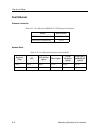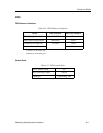
Attenuation to Client-Server
Glossary-2
Attenuation Loss of signal power (measured in decibels) due to transmission through
a cable. Attenuation is dependent on the type, manufacture and
installation quality of cabling, and is expressed in units of loss per length,
most often dB/m.
AUI Attachment Unit Interface. A cabling type used in Ethernet networks,
designed to connect network stations and devices to transceivers.
Backbone A portion of a network which provides the interconnection of a number
of separate, smaller networks.
Bit Binary Digit. A bit is the smallest unit of information, consisting of a
single binary number. A bit is represented by a numerical value of 1 or 0.
BOOTP Bootstrap Protocol. Checks MIB variables of an SNMP manageable
device to determine whether it should start up using its existing firmware
or boot up from a network server specifically configured for the purpose.
Bridge Bridges are network devices which connect two or more separate
network segments while allowing traffic to be passed between the
separate networks when necessary. Bridges read in packets and decide to
either retransmit them or block them based on the destination to which
the packets are addressed.
BRIM Bridge/Router Interface Module. BRIMs are added to BRIM-capable
Cabletron Systems equipment to provide connections to external
networks through an integrated bridge or router.
Broadcast A type of network transmission; a broadcast transmission is one which is
sent to every station on the network, regardless of location, identification,
or address.
Buffered Uplink A type of Fast Ethernet connection that provides retiming and
regeneration of signals. In effect, the buffered uplink provides the
distance characteristics of a bridged connection without performing
actual segmentation.
Client A workstation or node which obtains services from a server device
located on the network.
Client-Server A computing model which is based on the use of dedicated devices
(servers) for the performance of specific computational or networking
tasks. These servers are accessed by several clients, workstations which
cannot perform those functions to the same extent or with the same
efficiency as the servers.


















